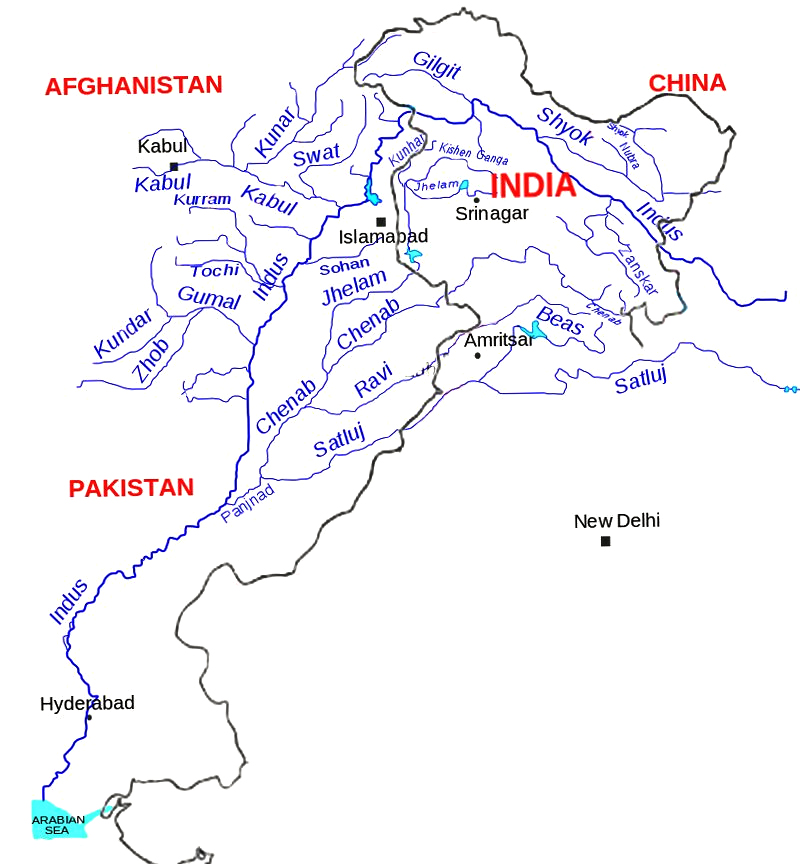Haryana
Inter-Basin Indus Water Transfer Plan
- 19 Jun 2025
- 5 min read
Why in News?
India has begun work on a major inter-basin water transfer plan to fully use its share of Indus waters. A feasibility study is underway for a 113-km canal linking the Chenab to the Ravi-Beas-Sutlej system to divert surplus water from Jammu & Kashmir to Punjab, Haryana, and Rajasthan.
Key Points
- Objective of the Project: To optimally use both eastern (Ravi, Beas, Sutlej) and western (Indus, Jhelum, Chenab) rivers, thereby reducing excess water flowing into Pakistan under the Indus Waters Treaty framework.
- Canal Integration Plan: The proposed 113-km canal will link the Chenab with the Ravi-Beas-Sutlej system.
- This canal network will integrate with 13 existing canal systems across Jammu & Kashmir, Punjab, Haryana, and Rajasthan, and will eventually feed into the Indira Gandhi Canal (longest canal in the country), ensuring regional water redistribution.
- This internal reallocation will also enhance India’s water resilience amid growing climate variability and changing rainfall patterns.
- Supporting Infrastructure Developments: Under the Canal Integration Plan Centre is considering doubling the length of the Ranbir canal, and the long-pending Ujh multipurpose project in Kathua district is being revived.
- The second Ravi-Beas link, previously planned to prevent excess Ravi water from flowing into Pakistan, will now become part of the broader canal network. This project involves constructing a barrage and a tunnel to transfer water from the Ujh (a Ravi tributary) to the Beas basin.
- Ongoing Short-Term Measures: India continues to desilt Baglihar and Salal hydroelectric reservoirs on the Chenab to improve water storage and usage.
- India is accelerating work on key hydroelectric projects like Pakal Dul on a tributary Marusadar River (1,000 Megawatts (MW)), Ratle (850 MW), Kiru (624 MW), and Kwar (540 MW) on Chenab river to enhance Indus basin water utilisation.
Indus River
- Source:
- The Indus (In Tibetan called Sengge Chu/‘Lion River’), a major river in South Asia, originates in Tibet near Mansarovar Lake in the Trans-Himalaya.
- The river flows through Tibet, India and Pakistan and about 200 million people live in the area of its drainage basin.
- Course and Major Tributaries:
- It enters India through Ladakh and flows through Jammu and Kashmir before reaching Pakistan's Gilgit-Baltistan region.
- The major left-bank tributaries of the Indus River are the Zaskar, Suru, Soan, Jhelum, Chenab, Ravi, Beas, Satluj, and Panjnad rivers.
- The major right-bank tributaries are Shyok, Gilgit, Hunza, Swat, Kunnar, Kurram, Gomal, and Kabul rivers.
- The Indus River empties into the Arabian Sea near the city of Karachi in southern Pakistan.
- Indus Water Treaty (IWT): The IWT signed in 1960, between India and Pakistan and was brokered by the World Bank.
- The treaty sets out a mechanism for cooperation and information exchange between the two sides on the use of the water of the Indus River and its five tributaries Sutlej, Beas, Ravi, Jhelum, and Chenab.
- India has suspended the IWT until Pakistan ceases its support for cross-border terrorism. It reflects a shift in India’s strategic calculus, using hydrological leverage as a pressure tool.
Chenab River
- Source:
- The river is formed by the confluence of the Chandra and Bhaga rivers at Tandi in the upper Himalayas, located in the Lahaul and Spiti district of Himachal Pradesh.
- The Chandra and the Bhaga originate from the south-west and north-west faces of Barelacha pass respectively in the Himalayan canton of Lahul and Spiti valley in Himachal Pradesh.
- Flows Through: It flows through the Jammu region of Jammu and Kashmir into the plains of Punjab, Pakistan, before flowing into the Indus River.








